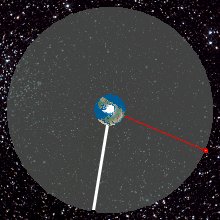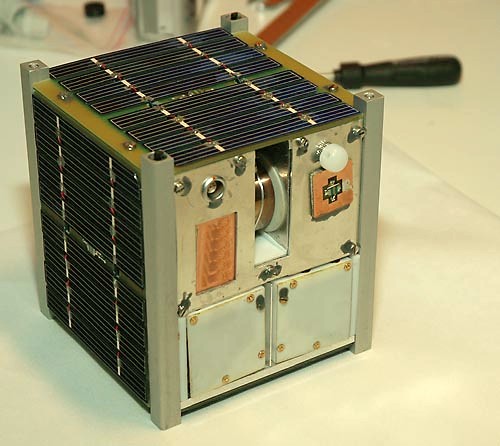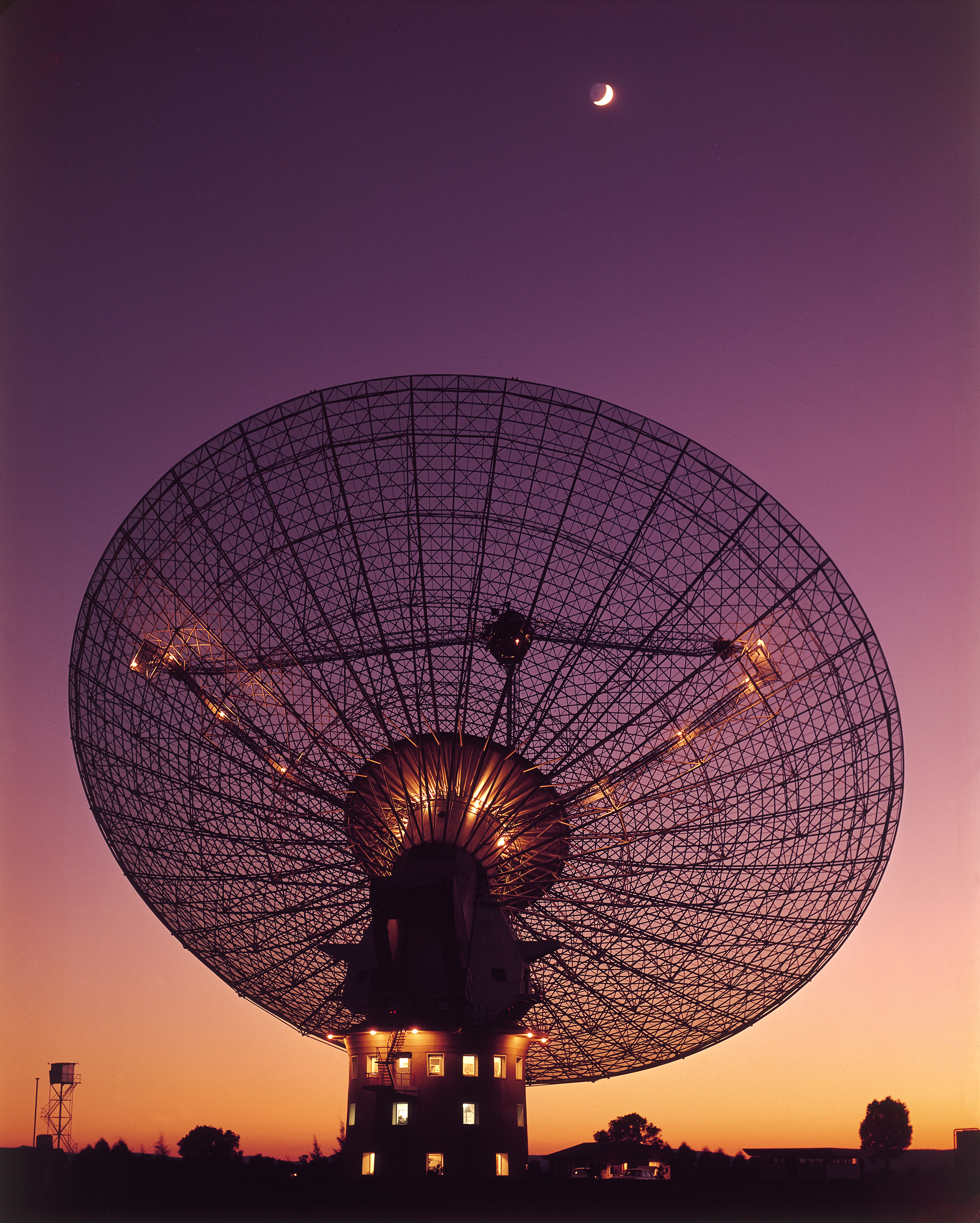|
Satellite
A satellite or an artificial satellite is an object, typically a spacecraft, placed into orbit around a celestial body. They have a variety of uses, including communication relay, weather forecasting, navigation ( GPS), broadcasting, scientific research, and Earth observation. Additional military uses are reconnaissance, early warning, signals intelligence and, potentially, weapon delivery. Other satellites include the final rocket stages that place satellites in orbit and formerly useful satellites that later become defunct. Except for passive satellites, most satellites have an electricity generation system for equipment on board, such as solar panels or radioisotope thermoelectric generators (RTGs). Most satellites also have a method of communication to ground stations, called transponders. Many satellites use a standardized bus to save cost and work, the most popular of which are small CubeSats. Similar satellites can work together as groups, forming constellatio ... [...More Info...] [...Related Items...] OR: [Wikipedia] [Google] [Baidu] |
Geostationary Orbit
A geostationary orbit, also referred to as a geosynchronous equatorial orbit''Geostationary orbit'' and ''Geosynchronous (equatorial) orbit'' are used somewhat interchangeably in sources. (GEO), is a circular orbit, circular geosynchronous orbit in altitude above Earth's equator, in radius from Earth's center, and following the retrograde and prograde motion, direction of Earth's rotation. An object in such an orbit has an orbital period equal to Earth's rotational period, one sidereal time, sidereal day, and so to ground observers it appears motionless, in a fixed position in the sky. The concept of a geostationary orbit was popularised by the science fiction writer Arthur C. Clarke in the 1940s as a way to revolutionise telecommunications, and the first satellite to be placed in this kind of orbit was launched in 1963. Communications satellites are often placed in a geostationary orbit so that Earth-based satellite dish, satellite antennas do not have to rotate to track t ... [...More Info...] [...Related Items...] OR: [Wikipedia] [Google] [Baidu] |
Space Debris
Space debris (also known as space junk, space pollution, space waste, space trash, space garbage, or cosmic debris) are defunct human-made objects in spaceprincipally in Earth orbitwhich no longer serve a useful function. These include derelict spacecraft (nonfunctional spacecraft and abandoned launch vehicle stages), mission-related debris, and particularly numerous in-Earth orbit, fragmentation debris from the breakup of derelict rocket bodies and spacecraft. In addition to derelict human-made objects left in orbit, space debris includes fragments from disintegration, erosion, or collisions; solidified liquids expelled from spacecraft; unburned particles from solid rocket motors; and even paint flecks. Space debris represents a risk to spacecraft. Space debris is typically a negative externality. It creates an external cost on others from the initial action to launch or use a spacecraft in near-Earth orbit, a cost that is typically not taken into account nor fully accoun ... [...More Info...] [...Related Items...] OR: [Wikipedia] [Google] [Baidu] |
Satellite Constellation
A satellite constellation is a group of artificial satellites working together as a system. Unlike a single satellite, a constellation can provide permanent global or near-global pass (spaceflight), coverage, such that at any time everywhere on Earth at least one satellite is visible. Satellites are typically placed in sets of complementary orbital plane (astronomy), orbital planes and connect to globally distributed ground stations. They may also use Inter-satellite service, inter-satellite communication. Other satellite groups Satellite constellations should not be confused with: * ''satellite clusters'', which are groups of satellites moving very close together in almost identical orbits (see satellite formation flying); * '':Satellite series, satellite series'' or ''satellite programs'' (such as Landsat program, Landsat), which are generations of satellites launched in succession; * ''satellite fleets'', which are groups of satellites from the same manufacturer or operator tha ... [...More Info...] [...Related Items...] OR: [Wikipedia] [Google] [Baidu] |
CubeSat
A CubeSat is a class of small satellite with a form factor of cubes. CubeSats have a mass of no more than per unit,, url=https://static1.squarespace.com/static/5418c831e4b0fa4ecac1bacd/t/5f24997b6deea10cc52bb016/1596234122437/CDS+REV14+2020-07-31+DRAFT.pdf , title=Cubesat Design Specification , publisher=California Polytechnic State University, San Luis Obispo, Cal Poly SLO , year=2020 , location=San Luis Obispo , pages=12 and often use commercial off-the-shelf (COTS) components for their electronics and structure. CubeSats are deployed into orbit from the International Space Station, or launched as secondary payloads on a launch vehicle. , more than 2,300 CubeSats have been launched. In 1999, California Polytechnic State University (Cal Poly) professor Jordi Puig-Suari and Bob Twiggs, a professor at Stanford University Space Systems Development Laboratory, developed the CubeSat specifications to promote and develop the skills necessary for the design, manufacture, and testing of ... [...More Info...] [...Related Items...] OR: [Wikipedia] [Google] [Baidu] |
Natural Satellites
A natural satellite is, in the most common usage, an astronomical body that orbits a planet, dwarf planet, or small Solar System body (or sometimes another natural satellite). Natural satellites are colloquially referred to as moons, a derivation from the Moon of Earth. In the Solar System, there are six planetary satellite systems containing 418 known natural satellites altogether. Seven objects commonly considered dwarf planets by astronomers are also known to have natural satellites: , Pluto, Haumea, , Makemake, , and Eris. As of January 2022, there are 447 other minor planets known to have natural satellites. A planet usually has at least around 10,000 times the mass of any natural satellites that orbit it, with a correspondingly much larger diameter. The Earth–Moon system is a unique exception in the Solar System; at 3,474 kilometres (2,158 miles) across, the Moon is 0.273 times the diameter of Earth and about of its mass. The next largest ratios are the N ... [...More Info...] [...Related Items...] OR: [Wikipedia] [Google] [Baidu] |
Launch Cost
Space launch market competition is the manifestation of market forces in the launch service provider business. In particular it is the trend of competitive dynamics among payload transport capabilities at diverse prices having a greater influence on launch purchasing than the traditional political considerations of country of manufacture or the national entity using, regulating or licensing the launch service. Following the advent of spaceflight technology in the late 1950s, space launch services came into being, exclusively by national programs. Later in the 20th century commercial operators became important customers of launch providers. International competition for the communications satellite payload subset of the launch market was increasingly influenced by commercial considerations. However, even during this period, for both commercial- and government-entity-launched commsats, the launch service providers for these payloads used launch vehicles built to governmen ... [...More Info...] [...Related Items...] OR: [Wikipedia] [Google] [Baidu] |
Ground Station
A ground station, Earth station, or Earth terminal is a terrestrial radio station designed for extraplanetary telecommunication with spacecraft (constituting part of the ground segment of the spacecraft system), or reception of radio waves from astronomical radio sources. Ground stations may be located either on the surface of the Earth, or in its atmosphere. Earth stations communicate with spacecraft by transmitting and receiving radio waves in the super high frequency (SHF) or extremely high frequency (EHF) bands (e.g. microwaves). When a ground station successfully transmits radio waves to a spacecraft (or vice versa), it establishes a telecommunications link. A principal telecommunications device of the ground station is the parabolic antenna. Ground stations may have either a fixed or itinerant position. Article 1 § III of the International Telecommunication Union (ITU) Radio Regulations describes various types of stationary and mobile ground stations, and their inte ... [...More Info...] [...Related Items...] OR: [Wikipedia] [Google] [Baidu] |
Low Earth Orbit
A low Earth orbit (LEO) is an geocentric orbit, orbit around Earth with a orbital period, period of 128 minutes or less (making at least 11.25 orbits per day) and an orbital eccentricity, eccentricity less than 0.25. Most of the artificial objects in outer space are in LEO, peaking in number at an altitude around , while the farthest in LEO, before medium Earth orbit (MEO), have an altitude of 2,000 km, about one-third of the Earth radius, radius of Earth and near the beginning of the Van Allen radiation belt#Inner belt, inner Van Allen radiation belt. The term ''LEO region'' is used for the area of space below an altitude of (about one-third of Earth's radius). Objects in orbits that pass through this zone, even if they have an apogee further out or are sub-orbital spaceflight, sub-orbital, are carefully tracked since they present a collision risk to the many LEO satellites. No human spaceflights other than the lunar missions of the Apollo program (1968-1972) have gone beyond L ... [...More Info...] [...Related Items...] OR: [Wikipedia] [Google] [Baidu] |
Satellite Bus
A satellite bus (or spacecraft bus) is the main body and structural component of a satellite or spacecraft, in which the payload and all scientific instruments are held. Bus-derived satellites are less customized than specially-produced satellites, but have specific equipment added to meet customer requirements, for example with specialized sensors or transponders, in order to achieve a specific mission. They are commonly used for geosynchronous satellites, particularly communications satellites, but are most commonly used in spacecraft which occupy low Earth orbit missions. Examples Some satellite bus examples include: * Boeing DS&S 702 * Lockheed Martin Space Systems A2100 * Moog Inc. SL-OMV, Meteor, Meteorite * * INVAP ARSAT-3K * Airbus D&S Eurostar * ISRO's I-1K, I-2K, I-3K, I-4K, I-6K, and Indian Mini Satellite bus * NASA Ames MCSB * SSL 1300 * family * Orbital ATK Star Bus family, inc GEOStar * Mitsubishi Electric DS2000 * Spacecraft bus of the Jam ... [...More Info...] [...Related Items...] OR: [Wikipedia] [Google] [Baidu] |
Spacecraft Propulsion
Spacecraft propulsion is any method used to accelerate spacecraft and artificial satellites. In-space propulsion exclusively deals with propulsion systems used in the vacuum of space and should not be confused with space launch or atmospheric entry. Several methods of pragmatic spacecraft propulsion have been developed, each having its own drawbacks and advantages. Most satellites have simple reliable chemical thrusters (often monopropellant rockets) or resistojet rockets for orbital station-keeping, while a few use Reaction wheel, momentum wheels for attitude control. Russian and antecedent Soviet bloc satellites have used Spacecraft electric propulsion, electric propulsion for decades, and newer Western geo-orbiting spacecraft are starting to use them for north–south station-keeping and orbit raising. Interplanetary vehicles mostly use chemical rockets as well, although a few have used electric propulsion such as ion thrusters and Hall-effect thrusters. Various technologies ... [...More Info...] [...Related Items...] OR: [Wikipedia] [Google] [Baidu] |
Spacecraft
A spacecraft is a vehicle that is designed spaceflight, to fly and operate in outer space. Spacecraft are used for a variety of purposes, including Telecommunications, communications, Earth observation satellite, Earth observation, Weather satellite, meteorology, navigation, space colonization, Planetary science, planetary exploration, and Space transport, transportation of Human spaceflight, humans and cargo spacecraft, cargo. All spacecraft except single-stage-to-orbit vehicles cannot get into space on their own, and require a launch vehicle (carrier rocket). On a sub-orbital spaceflight, a space vehicle enters space and then returns to the surface without having gained sufficient energy or velocity to make a full Geocentric orbit, Earth orbit. For orbital spaceflights, spacecraft enter closed orbits around the Earth or around other Astronomical object, celestial bodies. Spacecraft used for human spaceflight carry people on board as crew or passengers from start or on orbit ... [...More Info...] [...Related Items...] OR: [Wikipedia] [Google] [Baidu] |
Transponder (satellite Communications)
A communications satellite's transponder is the series of interconnected units that form a communications channel between the receiving and the transmitting antennas. It is mainly used in satellite communication to transfer the received signals. A transponder is typically composed of: * an input band-limiting device (an input band-pass filter), * an input low-noise amplifier (LNA), designed to amplify the signals received from the Earth station (normally very weak, because of the large distances involved), * a frequency translator (normally composed of an oscillator and a frequency mixer) used to convert the frequency of the received signal to the frequency required for the transmitted signal, * an output band-pass filter, * a power amplifier (this can be a traveling-wave tube or a solid-state amplifier). Most communication satellites are radio relay stations in orbit and carry dozens of transponders, each with a Bandwidth (signal processing), bandwidth of tens of megahertz. M ... [...More Info...] [...Related Items...] OR: [Wikipedia] [Google] [Baidu] |










